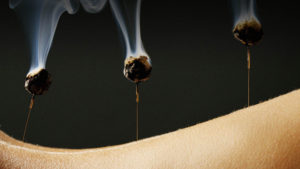Moxibustion

Moxibustion
Moxibustion is the burning/smouldering of the herb known as Mugwort (botanically known as artemisa agyii, princeps or montanta) that has been dried, processed and aged so that it is a punk (soft downy fluff made from the hairs and oil of the leaves) or rolled into cigar-like sticks (this uses more fibrous parts of the plant). Moxa is burnt on or near acu-points in the body.
The use of Moxa has been recorded from 100 or 300 BC. In one of the biggest archeological discoveries of the 20th century, in China, inside the Ma Wang Dui tombs, there were found two silk scrolls devoted entirely to Moxibustion and channel theory. It pre-dates acupuncture. It has been cited that Moxibustion use is what brought about an understanding of the channels (meridians).
Historically, both in Asia and Europe, at the same time of year (spring), people would hang Mugwort from their windows and door frames, or put it on their roof, to ‘ward off evil spirits’ as part of particular festival rituals.
What they didn’t know at that time was that mosquitoes carried deadly blood-borne pathogens and that Mugwort has natural insect-repelling properties. So the house protected by mugwort was less likely to become infected.
Moxibustion has traditionally been medicine for the people, for the villages. With the introduction of metal working techniques, acupuncture arose and so channel theory developed and with it a culture of the Scholar-Physician. These generations of doctors developed medicine and wrote extremely influential texts, but fundamentally existed to serve the upper echelons of society – the Emperor/Empress and their court.
Thought to lack sophistication, Moxibustion was disregarded in this arena, except when all else failed and as a preventative to prolong life.
It was really after the Buddhists took medicine to Japan that Moxa began to flourish and develop. In Japan, Moxibustion is regarded as a serious branch of medicine; just as one can specialise to become a herbalist or an acupuncturist, one can be a Moxibustionist there.
Qualities of Mugwort
Mugwort is a hardy weed that grows in places like old car yards, cracks in a pavement, along highways, countryside and more.
Its smoke contains no carcinogens, and is used as anti-bacterial fumigant. Mugwort been used as a purifying agent across the globe from North American indigenous tribes to Buddhist and shinto shrines in Japan and China.
How does Moxa work?
The Moxibustion effect is two-fold: a heat and a chemical trigger.
The Heat: Moxa’s heat has a particular signature. It emits an infra-red ray that is akin to the skin. This far-infra ray is known to be conducive to the health of the cells. The heat triggers a response in heat receptor proteins which in turn generates a systemic repair response.
The Chemical Trigger: As the Moxa burns, it generates an oil which infuses the skin. This then sets off a bio-chemical reaction in the body.
Acu-Points for Moxibustion
There still needs to be more research on this herb and technique, but most of the research that has been done is on the acu-point known as Stomach 36 (ST-36) or Zu San Li. You can also perform Moxa on many other points of the body. It maintains the effects of your acupuncture treatment, but it’s also super powerful for:
- fatigue
- pain – joints/ stomach / menstrual
- immunity
Book An Appointment
Book a Moxibustion therapy appointment.
